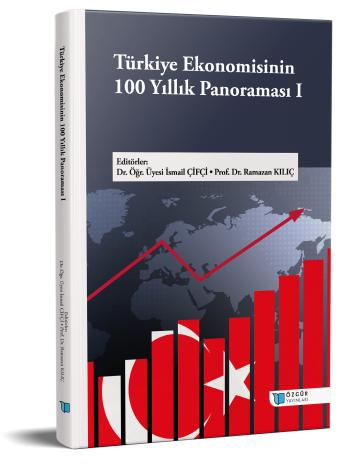
Cumhuriyetin 100 Yıllık Ekonomik Büyümesi
Şu kitabın bölümü:
Çifçi,
İ.
&
Kılıç,
R.
(eds.)
2024.
Türkiye Ekonomisinin 100 Yıllık Panoraması I.
Özet
Bu çalışmanın amacı Türkiye Cumhuriyetin kuruluş yılı olan 1923’den 2022 yılına kadar olan 100 yıllık süreçteki ekonomik performansını, üretim ve talep yapısındaki değişimleri dönemler itibarıyla ortaya koymaktır. Bu amaç doğrultusunda çalışmada öncelikle Gayri Safi Yurtiçi Hasıla, Gayri Safi Milli Hasıla ve ekonomik büyüme, konjonktürel dalgalanmalar, kısa dönem ve uzun dönem ekonomik büyüme kavramları açıklanmıştır. Çalışmada 1998-2023 dönemi toplam talebin yapısı, Türkiye ekonomisinin üretim bileşenleri ve üretim faktörlerinin gelirden aldıkları paylar incelenmiştir. Son olarak Türkiye’nin 100 yıllık süreçte sergilediği ekonomik büyüme performansı dönemler itibarıyla incelenerek Türkiye’nin bu dönemlerde sergilediği ekonomik büyümesi günümüz gelişmiş ve gelişmekte olan 30 ülke ile kıyaslanmıştır. Çalışmadaki bulgular şu şekilde özetlenebilir: i) Cumhuriyetin kuruluş yıllarında tarım ve sanayinin üretim içindeki payı sırasıyla ortalama % 45 ve %10 iken 2022 yılında bu oran sırasıyla %6 ve %27 olmuştur. ii) Türkiye kuruluşundan beri siyasi ve ekonomik istikrarsızlıklar yaşasa dahi her yıl ortalama %3.84 gibi çok yüksek bir ekonomik büyüme oranını yakalamış ve 100 yıllık süreçte Türkiye her 20 yılda bir gelirini ikiye katlamayı başarmıştır. iii) Türkiye, günümüz 30 gelişmiş ve gelişmekte olan ülkeyle kıyaslandığında 1923-2022 döneminde Rusya’dan sonra gelirini en fazla arttıran ikinci ülke olmuştur.

